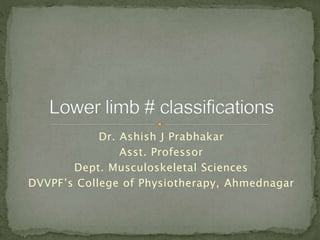Lower limb #
- 1. Dr. Ashish J Prabhakar Asst. Professor Dept. Musculoskeletal Sciences DVVPFâs College of Physiotherapy, Ahmednagar
- 2. ï Type A Stable ï A1: Fractures of the pelvis not involving the ring; avulsion injuries ï A2: Stable, minimal displacement of the ring
- 3. ï Type B: Rotationally unstable, vertically stable ï B1: External rotation instability; open-book injury ï B2: LC injury; internal rotation instability; ipsilateral only ï B3: LC injury; bilateral rotational instability (bucket handle)
- 4. ï Type C: Rotationally, and vertically unstable ï C1: Unilateral injury ï C2: Bilateral injury, one side rotationally unstable, with the contralateral side vertically unstable ï C3: Bilateral injury, both sides rotationally and vertically unstable with an associated acetabular fracture
- 5. Type I: Hip dislocation with fracture of the femoral head inferior to the fovea capitis femoris Type II: Hip dislocation with fracture of the femoral head superior to the fovea capitis femoris
- 6. Type III: Type I or II injury associated with fracture of the femoral neck Type IV: Type I or II injury associated with fracture of the acetabular rim
- 7. ï Type1- undispalced, uncommunited ï Type 2- displaced, minimal communition, lesser trochandric #, with varus ï Type 3- displaced, communited, grater trochandric #, varus ï Severe communition, subtrochandric extension, also reverse oblique # line.
- 8. ï Type I: At the level of the lesser trochanter ï Type II: <2.5 cm below the lesser trochanter ï Type III: 2.5 to 5 cm below the lesser trochanter
- 9. Thank You









